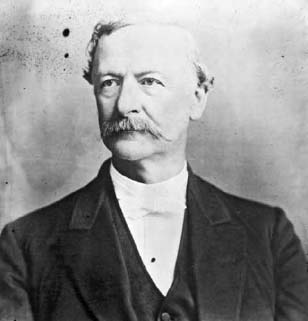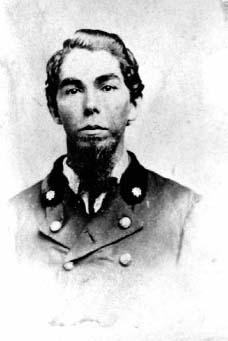The Battle of White Sulphur Springs (7 page)
Read The Battle of White Sulphur Springs Online
Authors: Eric J. Wittenberg

Lieutenant William H. “Will” Rumsey, aide-de-camp to Averell and commander of an expedition during the advance to White Sulphur Springs.
Ronnie Tront
The blue-clad troopers took the road to Huntersville as far as the town of Frost, a distance of about twenty-four miles. Lieutenant William H. “Will” Rumsey, one of Averell's aides-de-camp, led the way that day, and his detachment ran into about three hundred troopers of Colonel William L. Jackson's 19
th
Virginia Cavalry.
98
Jackson, a second cousin of the lamented Confederate hero Lieutenant General Thomas J. “Stonewall” Jackson, soon would earn the unflattering nickname of “Mudwall.” Unlike his famous kinsman, William Jackson, a thirty-eight-year-old judge and prominent politician from Clarksburg, was not known for his military prowess. He was a big man, standing six feet tall and tipping the scales at about two hundred pounds. He had piercing blue eyes like his famous cousin and also had a shock of dark red hair.
99
One of his former soldiers remembered him fondly. “The fact is, he was as brave a man as lived, and never refused to fight, when the attendant circumstances were anything like equal,” he claimed.
100
While Stonewall Jackson was most famous for his brigade's stand at the First Battle of Bull Run, Mudwall Jackson was notorious for giving way.
101
A Confederate soldier explained the origin of the nickname: “We called him âMudwall' in contradistinction from Stonewall Jackson because âOld Averill,' as we called Gen. Averill, always without an exception ran over him, knocked him down and ran him off.”
102

A postwar image of Colonel William L. “Mudwall” Jackson, commander of the 19
th
Virginia Cavalry.
Library of Congress
.
Jackson's large regiment came from the southeastern area of what became West Virginia, including Greenbrier County. His cavalry regiment was a new command, and poor discipline, straggling and absenteeism plagued it.
103
His company commanders had, until recently, been in independent commands, and they were not accustomed to taking orders or working together, and that significantly inhibited the effectiveness and efficiency of the regiment.
104
Jackson's primary responsibility was to secure the so-called Huntersville Line, which stretched for about thirty miles from southwestern Pocahontas County to Warm Springs in Highland County. Jackson also had a small detachment of infantry. His primary responsibility was to block any movement toward Staunton by Union forces, and he had deployed his forces accordingly. They were stationed in Highland and Pocahontas Counties, watching for activity along the Parkersburg and Staunton Turnpike and the Huntersville Road, and Jackson had to quickly call them back in order to try to block Averell's advance.
105
The question was whether this inefficient command would be able to halt Averell's advance.
Intelligence of Averell's raid reached Jackson almost immediately after the Federals marched again on August 18. Thus alerted, Jackson's detachments scouted the entire network of roads that could possibly be used by Averell. Although Jackson had the best possible intelligence regarding Averell's movements and intentions, he nevertheless proved to be ineffective at halting the advance of the Federal column.
106
Rumsey's determined attack drove Jackson's hardscrabble troopers down the Knapps Creek Valley to the Northwest Passage, or Narrows, between Huntersville and Minnehaha Springs, a gorge in the mountains through which the Marlins Bottom and Warm Springs Turnpike passes, about five miles from Huntersville. There, Jackson's routed men fell back upon the main body of the 19
th
Virginia Cavalry, which held a position in a ravine, “and in that canyon a handful of men might hold an army.”
107
Rumsey suffered four wounded and six horses killed and disabled despite being constantly annoyed by potshotting bushwhackers along the way. His command then bivouacked for the night, giving weary men and animals a chance to rest.
108
“Night comes and we camp on a Union man's farm,” noted a West Virginian. “His hay, rye, oats, and corn are literally devoured. Such families should be remunerated.”
109
Averell determined that the ravine “was difficult to carry on account of the precipitous character of the sides,” so he decided to feint with Gibson's Battalion on the twenty-second, while taking a byroad to the right with his main body. The main body reached Huntersville without meeting resistance, flanking Jackson out of his strong position in the ravine. Realizing that the Federals had flanked him and were about to get into their rear, Jackson and his cavalrymen beat a hasty retreat toward Warm Springs, leaving Huntersville in Averell's possession.
110
“His rear was fighting with our pickets. This we don't allow rebs to do, so the 8
th
[West] Virginia pursued them hotly, capturing five,” recorded a trooper of the 3
rd
West Virginia, whose regiment drew up in line of battle but did not charge during this rear guard action.
111
“He was so much afraid of being cut off from W Springs that he left precipitously,” noted Lieutenant Meigs.
112
Jackson downplayed his rout. “Ascertaining my position at Gatewood's to be not so tenable as I had supposed,” he wrote, “I moved my infantry that night to Jackson's River on the Warm Springs Road, leaving my cavalry a short distance below Gatewood's.”
113
The New Yorker sent Oley's 8
th
West Virginia and a squadron of the 3
rd
West Virginia in pursuit of the fleeing Confederates. “Heard of Rebelsâbut did not shoot any,” reported a member of the 8
th
West Virginia in his diary that day.
114
The pursuing blue-clads caught up to Jackson's rear guard at Camp Northwest, driving them several miles before calling off the pursuit. Camp Northwest was the first elaborate camp to be built during the Civil War. It was located along the Warm Springs and Marlins Bottom Turnpike not far from Huntersville, and there were substantial log buildings as well as much equipment and supplies stored there.
115
Averell's men burned Camp Northwest and destroyed its commissary buildings, stores, blacksmith shops, several wagons, a number of Enfield rifles, artillery equipment and a quantity of wheat and flour at a nearby mill. The Union troopers also seized a number of canteens, stretchers and hospital supplies that they found there.
116
The supplies were much needed. “We have lost a good many horses from exhaustion and have not found many for a remount as they are driven off when news of our advance arrives,” observed Lieutenant Meigs.
117
Oley's loss was one man badly woundedâhis leg had to be amputated.
118
Having fulfilled Kelley's orders to drive Jackson and his cavalry from Huntersville, Averell waited for the arrival of the 2
nd
and 10
th
West Virginia. The 10
th
West Virginia, about 350 troopers of the 2
nd
West Virginia and a two-gun section of Captain John V. Keeper's battery arrived from Beverly on August 23. The men of the 2
nd
West Virginia were slightly better supplied than the rest of Averell's commandâeach man had forty rounds in his cartridge box, and they also had one thousand extra rounds with them that were distributed to the troopers of the 3
rd
West Virginia.
119
The wait at Huntersville was not a pleasant respite for the Fourth Separate Brigade. “The fact was we had to fight the Johnnies continually all day to save ourselves from annihilation,” remembered the historian of the 14
th
Pennsylvania Cavalry with a shiver. “Many of us wrote in our diaries, âGod only knows whether one of us will ever see home or friends again.'”
120
Another member of the 14
th
Pennsylvania said simply, “The command was engaged in a continuous skirmish.”
121
Even though both men and animals needed a break from the travails of the campaign, this was not the sort of respite they had in mind.
“We have been dreadfully bushwhacked since we started on the trip,” recounted a disgusted Major Hedgeman Slack of the 8
th
West Virginia, who had been left behind to take command of the dismounted men and sick horses when the rest of the Fourth Separate Brigade moved on. “They scarcely ever do much harm. They are so cowardly they keep so far away they are not very dangerous but they some times hit. I was especially marked out by one of them there one day and he took one fast shot at me but missed me by several feet.”
122
The men of the 2
nd
West Virginia had a difficult march from Buckhannon to join Averell. “It required three days to make the march, and we were beset by bushwhackers almost continually,” recalled Samuel H. Knox. “Although we lost several men by this desultory fire, we could do nothing effectual to prevent it as the enemy were experienced mountaineers and always fired from some sheltered position, where all we could see of them was a wreath of smoke curling up among the rocks and bushes.”
123
Another member of the 2
nd
West Virginia recalled it as “a very dangerous and exciting march.” He noted, “We had considerable skirmishing, and our wagon train was attacked on the 21
st
, two of our men being wounded and several horses killed. The next day one of our command and two of the enemy were killed.”
124
Lieutenant Colonel John J. Polsley led a reconnaissance by a detachment of his 8
th
West Virginia toward Warm Springs on August 23. A few miles into their march, they ran into about three hundred Confederate horse soldiers of the 19
th
Virginia Cavalry under command of Lieutenant Colonel William P. Thompson. “After considerable skirmishing assisted by one company of the Fourteenth Pennsylvania Cavalry and a company of the Third [West] Virginia Mounted Infantry, I drove them eight or ten miles,” noted Colonel Oley in his report of the campaign.
125
The Federals captured a lieutenant and five enlisted men, probably of Thompson's regiment, while killing or wounding a dozen more. Polsley sustained only the loss of five horses on this excursion.
126

Lieutenant Colonel John J. Polsley of the 8
th
West Virginia Mounted Infantry.
Steve Cunningham
.
Averell and his entire command, less the 10
th
West Virginia and the section of Keepers's guns, both of which remained on garrison duty at Huntersville, pursued Jackson in the direction of Warm Springs on August 24. “The march was continued first up the Alleghany Mountains, then through gorges, up and down, and over the mountain,” recalled a Pennsylvanian.
127
After an ineffectual stand by the Confederate horse soldiers, the advancing Federals drove Jackson and his command through Rider Gap in Alleghany Mountain near Warm Springs in the direction of Millboro and near the state line.
Jackson dismounted about one hundred of the 20
th
Virginia Cavalry and ordered them up the slope of Alleghany Mountain to counter any flanking attempts by Averell. Part of this force crossed Back Creek Mountain via a footpath that terminated in Hidden Valley below. Averell's troopers chased the routed Confederates down this footpath. They captured “many arms, saddles, and other stores,” reported Averell, at the cost of “2 men severely wounded, some slightly hurt, and a few horses shot.” The panicked Confederates littered the roadside with saddles, bridles, guns, sabers and uniform parts as they fled.
128
The Fourth Separate Brigade camped at Bath Court House that night.
129